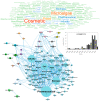Analysis of Scientific Research Driving Microalgae Market Opportunities in Europe
- PMID: 32443631
- PMCID: PMC7281102
- DOI: 10.3390/md18050264
Analysis of Scientific Research Driving Microalgae Market Opportunities in Europe
Abstract
A bibliographic database of scientific papers published by authors affiliated to research institutions worldwide, especially focused in Europe and in the European Atlantic Area, and containing the keywords "microalga(e)" or "phytoplankton" was built. A corpus of 79,020 publications was obtained and analyzed using the Orbit Intellixir software to characterize the research trends related to microalgae markets, markets opportunities and technologies that could have important impacts on markets evolution. Six major markets opportunities, the production of biofuels, bioplastics, biofertilizers, nutraceuticals, pharmaceuticals and cosmetics, and two fast-evolving technological domains driving markets evolution, microalgae harvesting and extraction technologies and production of genetically modified (GM-)microalgae, were highlighted. We here present an advanced analysis of these research domains to give an updated overview of scientific concepts driving microalgae markets.
Keywords: Europe; GMO; bibliometric; biofertilizers; bioplastics; biotechnology; cosmetics; food; market; microalgae; nutraceuticals; pharmaceuticals; research.
Conflict of interest statement
The authors declare they have no competing interests.
Figures










References
-
- Garrido-Cardenas J.A., Manzano-Agugliaro F., Acien-Fernandez F.G., Molina-Grima E. Microalgae research worldwide. Algal Res. 2018;35:50–60. doi: 10.1016/j.algal.2018.08.005. - DOI
Publication types
MeSH terms
Substances
Grants and funding
LinkOut - more resources
Full Text Sources
Medical

